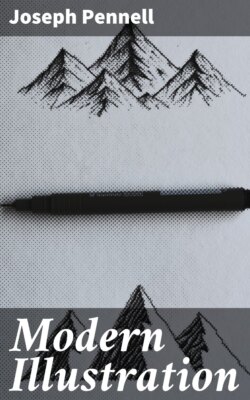Читать книгу Modern Illustration - Joseph Pennell - Страница 4
Footnote
ОглавлениеSince this preface was written much has happened, and I hope I have learned a little. A show of wood-engravings was held in March, 1895, in Stationers' Hall, which demonstrated clearly that there are many capable artists in this branch of illustration, though at present they have but little encouragement to practise their art; in that exhibition one saw much good work, and I must at least record the names of H. Harral and C. Roberts among English engravers on wood who have done notable large blocks—while excellent engraving has been recently accomplished by Messrs. M. Stainforth, O. Lacour, J. D. Cooper, R. Paterson, A. Worf, F. Babbage, J. M. Johnstone, and W. Spielmeyer, the latter of whom was good enough to give me much help in the German chapter of this book. Edmund Evans, the engraver and colour-printer, loaned me the original drawings on the wood by Birket Foster, William Harvey, and Harrison Weir, now for the first time reproduced, while William Archer allowed us to reproduce the Tegner on page 72.
Among artists too I should have noted the work of G. H. Thomas and Samuel Palmer, who made some designs for Sacred Allegories, mainly engraved by W. T. Green, 1856. One of the earliest and best of modern illustrated books, "Poets of the Nineteenth Century," 1857, and Wilmott's "Sacred Poetry," 1863, are worth preservation for their illustrations. The more I see of this illustration of twenty or thirty years ago, the better and more interesting I find it. Arthur Hughes' work grows on one; certainly his illustrations to Christina Rossetti's "Sing Song," are very charming. I have made no mention scarcely of the splendid work Charles Green, Luke Fildes, and Fred. Barnard did for Charles Dickens. My only excuse is that till yesterday I never saw it. Griset's grotesques, too, I have but just come across—but while one is looking up the work of a few years ago, that of the present is unseen. I have said nothing of many interesting illustrators who have come to the front almost within a few months, illustrators are being made almost daily, one cannot keep track of them, good as their work is much of it is like journalism, bound to perish, only the best will live; but when one is right in the midst of it, difficult indeed is the task of picking out the good from the almost good, the clever from the distinguished.
London,
September 30th, 1895.
BY A. S. HARTRICK. FROM A PEN DRAWING IN “THE DAILY CHRONICLE.”
BY CONSTABLE. PROCESS BLOCK FROM AN ORIGINAL DRAWING IN POSSESSION OF THE AUTHOR.
